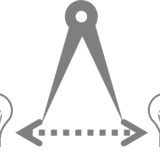Near and Far in Idea Space
One of the useful things about placing ideas in a spatial system is that you can talk about differentiation – the degree of difference between ideas, concepts, models, etc. – in a clear and explicit way.
The generative metaphor (“ideas are born”) or constructive metaphor (“ideas are made”) do not lend themselves as well to this kind of discussion.
To use our apple example, we can find a Red Delicious and a Golden Delicious apple pretty close to one other, in a space defined as “all apples”, just a step away along the color dimension. Granny Smith apples are farther away … different color AND different taste / texture (much more tart, crisp, etc.) If we widen the idea space to include “fruits that grow on trees”, then we can find examples that are even more distant … pears, for example, are characterized by a different shape, taste, name, species, etc. Even farther down the road is the proverbial “different than an apple” fruit, the orange.
By placing concepts on a spatial grid, we can discuss “how different” an idea is, by talking about how close or far away it is, even though the distance is purely abstract. I’ve found that it’s possible to get a roomful of people to discuss difference in spatial terms, and achieve consensus about how near and far different ideas are from each other.
In the process of brainstorming, this spatial analogue for “how different?” can be enormously useful. We can map an idea on the board, and say we’re looking for something close to that idea, or something really far away, and people will know what we’re talking about. We can talk about the direction of difference, and regroup ideas by different dimensions, as a way of exploring common characteristics.
Being explicit about the metaphors we use helps us employ them more deeply and widely, conscious of the tools we’re using to explore.

